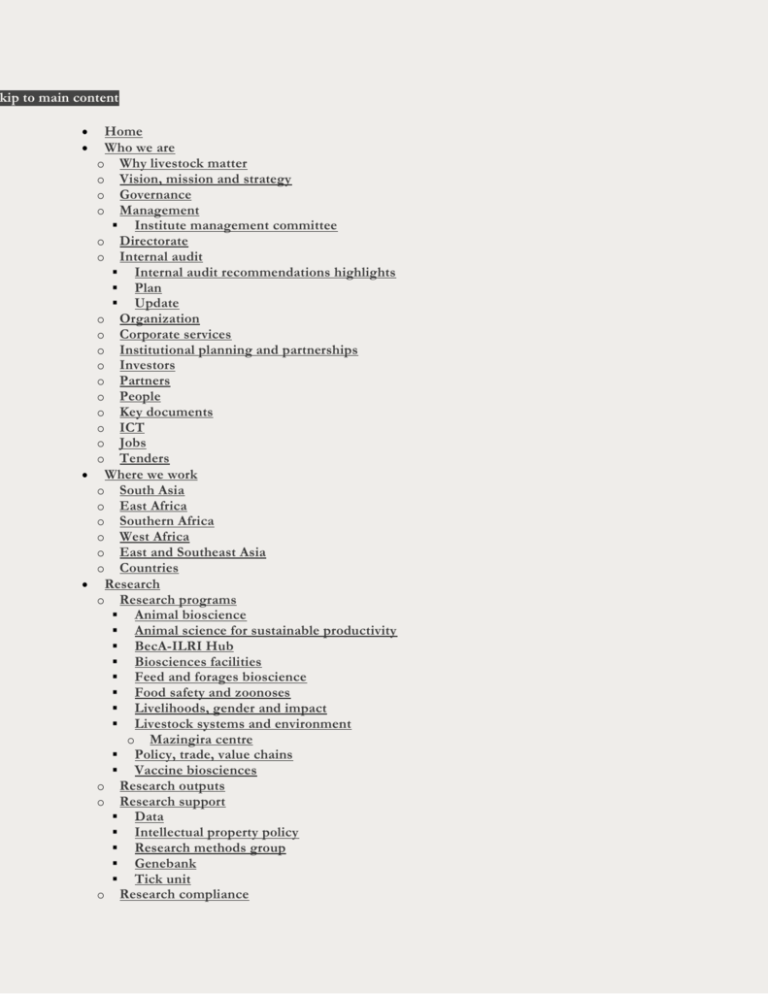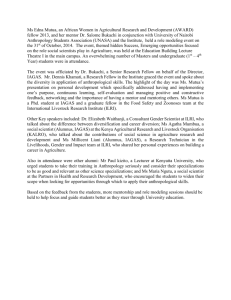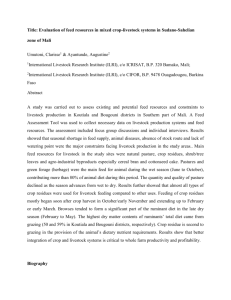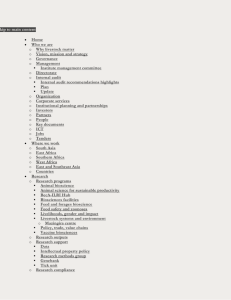Feed aggregator | International Livestock Research Institute
advertisement

kip to main content Home Who we are o Why livestock matter o Vision, mission and strategy o Governance o Management Institute management committee o Directorate o Internal audit Internal audit recommendations highlights Plan Update o Organization o Corporate services o Institutional planning and partnerships o Investors o Partners o People o Key documents o ICT o Jobs o Tenders Where we work o South Asia o East Africa o Southern Africa o West Africa o East and Southeast Asia o Countries Research o Research programs Animal bioscience Animal science for sustainable productivity BecA-ILRI Hub Biosciences facilities Feed and forages bioscience Food safety and zoonoses Livelihoods, gender and impact Livestock systems and environment o Mazingira centre Policy, trade, value chains Vaccine biosciences o Research outputs o Research support Data Intellectual property policy Research methods group Genebank Tick unit o Research compliance Animal care and use committee Biosafety committee Research ethics committee o Health and safety o Genebank o Technical consortium for building resilience o ILRI in CGIAR research programs Agriculture for nutrition and health Climate change, agriculture and food security Dryland systems Humidtropics Livestock and fish Managing and sustaining crop collections Policies, Institutions, and markets Water, land and ecosystems o Data o Open access Communications o Knowledge o Publications o Events o Media News Films Photos Audio Newsfeeds Info tools and resources Events calendar o News o RSS feeds o Research outputs repository o Info tools and resources o Acronyms o Publishing o ICT o Data o Open access o Social Capacity development Jobs Contact us login International Livestock Research Institute You are here Home » Feed aggregator Feed aggregator African Animal Annals: Deadly trifecta of climate change, population and disease? ILRI blogposts front page - Jan/2015 2015/01 - ILRI news African Animal Annals: Deadly trifecta of climate change, population and disease? Emerging Diseases Bookmarks - Jan/2015 2015/01 - ILRI news A ‘who’s who’ in livestock research-for-development gathering in Ethiopia ILRI Blogposts - Jan/2015 2015/01 - ILRI news A ‘who’s who’ in livestock research-for-development gathering in Ethiopia ILRI blogposts front page - Jan/2015 2015/01 - ILRI news A ‘who’s who’ in livestock research-for-development gathering in Ethiopia ILRI 40 bookmarks - Jan/2015 2015/01 - ILRI news Storify highlights of special livestock session at the Borlaug Dialogue in Iowa ILRI Blogposts - Jan/2015 2015/01 - ILRI news Storify highlights of special livestock session at the Borlaug Dialogue in Iowa ILRI blogposts front page - Jan/2015 2015/01 - ILRI news Storify highlights of special livestock session at the Borlaug Dialogue in Iowa ILRI 40 bookmarks - Jan/2015 2015/01 - ILRI news Highlights of a special ‘livestock evening’ at the Borlaug Symposium ILRI Blogposts - Jan/2015 2014/12 - ILRI news Highlights of a special ‘livestock evening’ at the Borlaug Symposium ILRI blogposts front page - Jan/2015 2014/12 - ILRI news Highlights of a special ‘livestock evening’ at the Borlaug Symposium ILRI 40 bookmarks - Jan/2015 2014/12 - ILRI news Climate-smart agriculture lives and breathes among smallholders in Kenya CRP 7 News - Jan/2015 Shamba Shape Up, a knowledge-based agricultural entertainment TV-show, has helped several smallscale farmers across East Africa adapt to a changing climate while boosting livelihoods and incomes. This has been possible through delivering information about climate-smart agriculture via an innovative concept: a dynamic presenter duo and agriculture experts that together with families conduct so called farm "make-overs". The CGIAR Research Program on Climate Change, Agriculture and Food Security (CCAFS) theme ‘Linking Knowledge to Action’ decided to conduct a minor, but in-depth analysis of the TV-show's impacts in Machakos County, Kenya. Here, Timothy Mburu, communication trainee, interviewed 18 farmers about their knowledge of and engagement with Shamba Shape Up, and which climate-smart agriculture techniques they had learned, as well as implemented, from the show (if any). The group also discussed whether or not they shared the information with fellow farmers, and what the show could improve further. Five of the 18 farmers were selected for further in-depth interviews while being filmed. Their sessions have been captured in the video documentary: “How TV-program Shamba Shape Up influences Kenya's farmers to adopt climate-smart agriculture." Background story: the collaboration with Shamba Shape Up The theme has been partnering with Shamba Shape Up and Mediae, the company who produces the TV-show, for almost two years. Through working with Mediae, CCAFS hopes to better identify and reach male and female farmers interested in climate-smart agriculture information and practices. This unique partnership links Mediae with several international agricultural research centres, including International Livestock Research Institute (ILRI), International Crops Research Institute for the Semi- Arid-Tropics (ICRISAT), World Agroforestry Centre (ICRAF) and International Potato Centre (CIP). The centers provide the latest agriculture and climate research results, while lending experts to the program where they show practical solutions to problems articulated by the farm families. CCAFS wants to see thousands to millions of farmers adapt to an increasingly variable climate through adoption of ‘climate-smart’ practices. Through the two-year partnership, CCAFS has been able to reach many more farmers than otherwise possible with climate-smart agriculture information, this since SSU is aired to over 10 million viewers in the East African region. The show’s positive farm and financial impacts have been reviewed and confirmed through two separate assessment reports, one released by University of Reading, UK as recently as October 2014 (download both documents further down). Farmers share their new climate-smart farming knowledge Many of the interviewed farmers said that they had learned something new from Shamba Shape Up, and a few of them had also implemented the practices they had seen. The most popular climate -smart farming practices, that farmers mentioned either learning about and/or implementing, included methods of rainwater harvesting and micro-irrigation, improved dairy and poultry farming, seed and soil analysis, how to use manure more efficiently during and between planting seasons, and how to best plant trees in and around the farm, so called agroforestry. Farmer Ann Kavuu said that through Shamba Shape Up, she had learned how to intercrop trees with crops. Anne has already managed to plant more than 200 of the Mukau tree on her plot, and has set a side a fairly large portion of her farm for future tree planting. She also learned that Briveria trees are important for nitrogen fixation, which is very beneficial for crops. Anne Kivuu said during her interview: I have seen a lot of benefits around the agroforestry part of my farm. I believe my trees are helping my shamba (farm) to be different from other shambas around. Some seasons people didn't harvest anything, but there is not a single season I've gone without harvesting something. So I believe it is because of the trees that I have grown." Mumo Mwendwa, a male farmer focusing on livestock and dairy production, said: I have learned about dairy farming; that I should keep fewer cows that will give me more milk, than to keep many cows that will give less milk." In the photo: Mumo preparing to feed his cows. Photo: T. Mburu After both learning and using the dairy farming and tree planting tips from Shamba Shape Up, I have seen that my income has increased. My income can now pay for my workers, our electricity bills, and other small needs on the farm, said Mumo Mwendwa during his session. Jemimah learned that the Fresian cow that she just bought wasn’t really suited for Machako's semi -arid climate. This helped explained the poor condition that her animal was in. She also learned how to vaccinate her cows against East Coast Fever, and how planting fruit trees, like mango and orange, could ensure an additional income and support adaptation to a more variable climate. In the photo: Jemimah and her husband John around their orange fruit trees. Photo: T. Mburu Knowledge sharing and further TV-show improvements A majority of the interviewed farmers mentioned that they have in the past shared the information from the show with other farmers, neighbors and relatives, indicating that the climate-smart agriculture information is something that farmers seek and want. This frequent information sharing helps SSU reach people beyond its viewers. The group also discussed how the show can improve further, mentioning that the program should air in the evenings instead, as more people would then be able to watch it. As of now, the TV-show airs around 15.00 pm on Saturday and Sunday when many are working in the fields. One farmer suggested that the messages of the experts featured on the show could be better translated, making it easier to understand and use on the farm. Learn more: - New Report: Assessing the Impacts of Shamba Shape Up (PDF) - From 2013: Knowledge, Attitude and Practice (KAP) report for Shamba Shape Up (PDF) - Blog: These are some of the impacts an agriculture TV-show can have Developing Livestock Feed Interventions with the Feed Assessment Tool (FEAST) CapDev outputs - Jan/2015 Developing Livestock Feed Interventions with the Feed Assessment Tool (FEAST) International Livestock Research Institute Developing livestock feed interventions with the feed assessment tool (FEAST): Module 15: Conclusion and postassessment Our latest outputs - Jan/2015 Developing livestock feed interventions with the feed assessment tool (FEAST): Module 15: Conclusion and post-assessment International Livestock Research Institute Developing Livestock Feed Interventions with the Feed Assessment Tool (FEAST) ILRI Partnerships and Communications outputs - Jan/2015 Developing Livestock Feed Interventions with the Feed Assessment Tool (FEAST) International Livestock Research Institute Developing livestock feed interventions with the feed assessment tool (FEAST): Module 15: Conclusion and postassessment Training and learning outputs - Jan/2015 Developing livestock feed interventions with the feed assessment tool (FEAST): Module 15: Conclusion and post-assessment International Livestock Research Institute Nutrient requirements and low-cost balanced diets, based on seasonally available local feedstuffs, for local pigs on smallholder farms in western Kenya Our latest outputs - Jan/2015 Nutrient requirements and low-cost balanced diets, based on seasonally available local feedstuffs, for local pigs on smallholder farms in western Kenya Carter, N.A.; Dewey, C.E.; Thomas, L.F.; Lukuyu, B.; Grace, D.; Lange, C. de Growth performance of pigs on smallholder farms in the tropics is low. Lack of feedstuffs, seasonal feed shortages, and feeding nutritionally unbalanced diets contribute to slow growth. Low-cost balanced diets are needed to improve pig performance. In this study, we estimated the nutrient requirements of local pigs on smallholder farms in Kenya and developed balanced low-cost diets using seasonally available local feedstuffs. Diets were formulated to provide pigs with 80 % of the nutrient density in corn and soybean meal-based (reference) diets to minimize the cost per unit of energy and other nutrients. Estimated requirements for starting and growing pigs (8 to 35 kg body weight) were as follows: digestible energy (DE) 2960 kcal/kg of dry matter (DM), standardized ileal digestibili ty (SID) lysine 5.8 g/kg of DM, calcium 2.8 g/kg of DM, standardized total tract digestible (STTD) phosphorous 1.4 g/kg of DM, and crude protein 85 g/kg of DM. Nutrient requirements of local pigs on smallholder farms in Kenya were lower than those of exotic breed pigs raised in commercial settings. Seasonally available local feedstuffs were used to develop low-cost balanced diets. Twenty-two diets are presented based on season, cost, and feedstuff availability. This study has broad applicability as a case s tudy of an approach that could be applied in other tropical regions in which smallholder pig keeping is practiced and where local feedstuffs for pigs are available seasonally. Nutrient requirements and low-cost balanced diets, based on seasonally available local feedstuffs, for local pigs on smallholder farms in western Kenya ILRI Market Opportunities Theme: Animal health and food safety for trade - Jan/2015 Nutrient requirements and low-cost balanced diets, based on seasonally available local feedstuffs, for local pigs on smallholder farms in western Kenya Carter, N.A.; Dewey, C.E.; Thomas, L.F.; Lukuyu, B.; Grace, D.; Lange, C. de Growth performance of pigs on smallholder farms in the tropics is low. Lack of feedstuffs, seasonal feed shortages, and feeding nutritionally unbalanced diets contribute to slow growth. Low-cost balanced diets are needed to improve pig performance. In this study, we estimated the nutrient requirements of local pigs on smallholder farms in Kenya and developed balanced low-cost diets using seasonally available local feedstuffs. Diets were formulated to provide pigs with 80 % of the nutrient density in corn and soybean meal-based (reference) diets to minimize the cost per unit of energy and other nutrients. Estimated requirements for starting and growing pigs (8 to 35 kg body weight) were as follows: digestible energy (DE) 2960 kcal/kg of dry matter (DM), standardized ileal digestibility (SID) lysine 5.8 g/kg of DM, calcium 2.8 g/kg of DM, standardized total tract digestible (STTD) phosphorous 1.4 g/kg of DM, and crude protein 85 g/kg of DM. Nutrient requirements of local pigs on smallholder farms in Kenya were lower than those of exotic breed pigs raised in commercial settings. Seasonally available local feedstuffs were used to develop low-cost balanced diets. Twenty-two diets are presented based on season, cost, and feedstuff availability. This study has broad applicability as a case study of an approach that could be applied in other tropical regions in which smallholder pig keeping is practiced and where local feedstuffs for pigs are available seasonally. Agri-health research: what have we learned and where do we go next? ILRI Market Opportunities Theme: Animal health and food safety for trade - Jan/2015 Agri-health research: what have we learned and where do we go next? Picchioni, F.; Aleksandrowicz, L.; Bruce, M.M.; Cuevas, S.; Dominguez-Salas, P.; Jia, L.; Tak, M. Understanding, facilitating and monitoring innovation platforms CapDev outputs - Jan/2015 Understanding, facilitating and monitoring innovation platforms CGIAR Research Program on Integrated Systems for the Humid Tropics; International Institute of Tropical Agriculture; Wageningen UR; International Livestock Research Institute Pages « first ‹ previous … 347 348 349 350 351 352 353 354 355 … next › last » Share | ILRI is a member of the CGIAR Consortium Grab our RSS Feeds Follow us on Twitter "Like" us on Facebook Slideshare Presentations Videos on YouTube See photos on Flickr See photos on Pinterest Follow us on LinkedIn Contact us | Copyright and permissions | Search| Subscribe © International Livestock Research Institute (ILRI)



